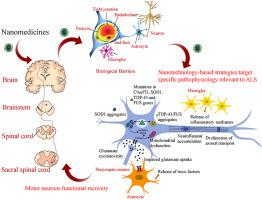Materials Today Bio ( IF 8.2 ) Pub Date : 2020-05-04 , DOI: 10.1016/j.mtbio.2020.100055 G Y Wang 1, 2 , S L Rayner 2 , R Chung 2 , B Y Shi 2, 3 , X J Liang 4

|
Amyotrophic lateral sclerosis (ALS), also known as motor neuron disease (MND), is a progressive neurodegenerative disease that affects both upper and lower motor neurons, which results in loss of muscle control and eventual paralysis [1]. Currently, there are as yet unresolved challenges regarding efficient drug delivery into the central nervous system (CNS). These challenges can be attributed to multiple factors including the presence of the blood-brain barrier (BBB), blood-spinal cord barrier (BSCB), as well as the inherent characteristics of the drugs themselves (e.g. low solubility, insufficient bioavailability/bio-stability, 'off-target' effects) etc. As a result, conventional drug delivery systems may not facilitate adequate dosage of the required drugs for functional recovery in ALS patients. Nanotechnology-based strategies, however, employ engineered nanostructures that show great potential in delivering single or combined therapeutic agents to overcome the biological barriers, enhance interaction with targeted sites, improve drug bioavailability/bio-stability and achieve real-time tracking while minimizing the systemic side-effects. This review provides a concise discussion of recent advances in nanotechnology-based strategies in relation to combating specific pathophysiology relevant to ALS disease progression and investigates the future scope of using nanotechnology to develop innovative treatments for ALS patients.
中文翻译:

基于纳米技术的肌萎缩侧索硬化症治疗策略的进展。
肌萎缩性脊髓侧索硬化症(ALS),也称为运动神经元病(MND),是一种进行性神经退行性疾病,同时影响上运动神经元和下运动神经元,导致肌肉失去控制并最终瘫痪[1]。目前,如何将药物有效输送至中枢神经系统(CNS)仍存在尚未解决的挑战。这些挑战可归因于多种因素,包括血脑屏障(BBB)、血脊髓屏障(BSCB)的存在以及药物本身的固有特性(例如溶解度低、生物利用度不足/生物利用度不足)。因此,传统的药物输送系统可能无法促进 ALS 患者功能恢复所需药物的足够剂量。然而,基于纳米技术的策略采用工程纳米结构,这些纳米结构在递送单一或组合治疗剂以克服生物屏障、增强与目标位点的相互作用、提高药物生物利用度/生物稳定性并实现实时跟踪方面显示出巨大潜力,同时最大限度地减少系统性副作用副作用。这篇综述简要讨论了基于纳米技术的策略的最新进展,这些策略与对抗 ALS 疾病进展相关的特定病理生理学有关,并探讨了使用纳米技术为 ALS 患者开发创新疗法的未来范围。

























 京公网安备 11010802027423号
京公网安备 11010802027423号